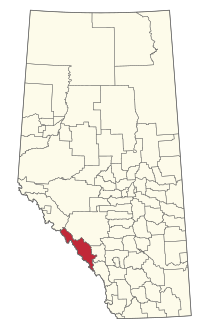Improvement District No. 9 facts for kids
Quick facts for kids
Improvement District No. 9 (Banff)
|
|
|---|---|

Location within Alberta
|
|
| Country | Canada |
| Province | Alberta |
| Region | Alberta's Rockies |
| Census division | No. 15 |
| Established | April 1, 1945 |
| Renumbered | January 1, 1969 |
| Area
(2021)
|
|
| • Land | 6,751.09 km2 (2,606.61 sq mi) |
| Population
(2021)
|
|
| • Total | 1,004 |
| • Density | 0.1/km2 (0.3/sq mi) |
| Time zone | UTC−7 (MST) |
| • Summer (DST) | UTC−6 (MDT) |
| Website | http://improvementdistrict9.ca |
Improvement District No. 9 (Banff), or Improvement District No. 9, is an improvement district in Alberta, Canada. Coextensive with Banff National Park in Alberta's Rockies, the improvement district is the municipality that provides local government for the portion of the park outside the Town of Banff.
History
Improvement District (I.D.) No. 9 was originally formed as I.D. No. 51 on April 1, 1945 through the amalgamation of I.D. Nos. 224, 255, 285, and 317, as well as portions of I.D. Nos. 193, 223, 253, 254, 284, 314, 315, 316, 347, 348, and 378. I.D. No. 51 was renumbered to I.D. No. 9 on January 1, 1969.
Formerly part of I.D. No. 9, Banff separated from the improvement district and incorporated as a town on January 1, 1990.
Geography
Communities and localities
|
The following urban municipalities are surrounded by Improvement District No. 9:
The following hamlets are located within Improvement District No. 9:
|
The following localities are located within Improvement District No. 9:
|
Demographics
In the 2021 Census of Population conducted by Statistics Canada, Improvement District No. 9 had a population of 1,004 living in 111 of its 123 total private dwellings, a change of -2.3% from its 2016 population of 1,028. With a land area of 6,751.09 km2 (2,606.61 sq mi), it had a population density of 0.1/km2 (0.26/sq mi) in 2021.
In the 2016 Census of Population conducted by Statistics Canada, Improvement District No. 9 had a population of 1,028 living in 30 of its 31 total private dwellings, a change of -12.5% from its 2011 population of 1,175. With a land area of 6,787.28 km2 (2,620.58 sq mi), it had a population density of 0.2/km2 (0.52/sq mi) in 2016.

